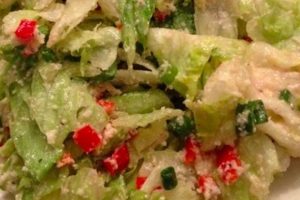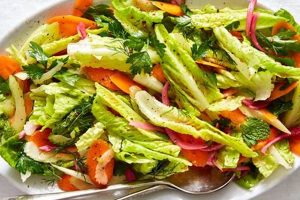Dishes featuring this root vegetable as the primary ingredient offer a wide range of flavor profiles, from bright and citrusy to earthy and savory. Common preparations involve shredding or dicing the celery root, often combining it with other vegetables, fruits, nuts, cheeses, and a variety of dressings. Examples include a classic remoulade, a vibrant slaw with apple and walnuts, or a more substantial salad with roasted root vegetables and a vinaigrette.
Known for its subtle celery-like flavor and satisfying crunch, celeriac (another name for celery root) offers nutritional benefits as a good source of dietary fiber, vitamin K, and vitamin C. Historically, celery root has been cultivated for centuries, initially valued for its medicinal properties before becoming a culinary staple. Its versatility allows for inclusion in diverse cuisines and dietary preferences, making it an appealing option for both home cooks and professional chefs.
This exploration delves into the preparation techniques, flavor combinations, and nutritional aspects of various celeriac salad options, providing a comprehensive guide for incorporating this unique ingredient into a healthy and flavorful diet. Topics covered will include selecting and preparing the root, complementary ingredient pairings, dressing options, and variations suitable for different seasons.
Tips for Celery Root Salad Preparation
Achieving optimal flavor and texture when preparing dishes based on this unique root vegetable requires attention to detail. The following tips offer guidance for successful preparation and enjoyable results.
Tip 1: Selecting and Storing Celery Root: Choose firm, unblemished roots that feel heavy for their size. Store unwashed celery root in a perforated plastic bag in the refrigerator crisper drawer for up to two weeks.
Tip 2: Efficient Peeling Techniques: Use a sharp chef’s knife to remove the tough outer skin, ensuring all brown spots and blemishes are eliminated. A vegetable peeler may prove less effective due to the root’s knobby surface.
Tip 3: Preventing Discoloration: Celery root oxidizes quickly upon exposure to air. To prevent browning, place peeled and cut celery root in a bowl of acidulated water (water with a squeeze of lemon juice) until ready to use.
Tip 4: Cutting Methods for Desired Texture: Match the cutting technique to the desired salad style. Thinly slice or julienne for delicate salads, dice for chunkier textures, or grate for a slaw-like consistency.
Tip 5: Balancing Flavors: Celery root’s earthy flavor pairs well with a range of ingredients. Balance the subtle celery notes with complementary flavors such as bright citrus, tart apple, pungent cheeses, or toasted nuts.
Tip 6: Dressing Choices: Creamy dressings, such as remoulade or aioli, complement celery root’s texture and flavor. Vinaigrettes offer a lighter alternative, particularly with salads incorporating other vegetables or fruits.
Tip 7: Serving and Storage: Celery root salads are best served fresh, but can be stored in an airtight container in the refrigerator for up to two days. The texture may soften slightly upon storage.
By following these guidelines, one can consistently create dishes that highlight the unique flavor and textural qualities of celeriac while maximizing nutritional value.
The combination of these preparatory techniques and creative flavor pairings ensures a successful and satisfying culinary experience.
1. Ingredient Selection
Ingredient selection significantly impacts the final flavor profile and overall quality of celery root salads. Thoughtful choices elevate this humble root vegetable into a star ingredient, creating dishes that are both delicious and visually appealing. Considerations range from the celery root itself to complementary vegetables, fruits, nuts, cheeses, and dressings.
- Celery Root Quality
Selecting a firm, heavy celery root with minimal blemishes ensures optimal flavor and texture. Avoid roots with soft spots or signs of decay. Proper storage, in a perforated bag in the refrigerator crisper, maintains freshness until preparation. The root’s inherent earthy flavor forms the base upon which other ingredients build, necessitating a quality starting point.
- Complementary Vegetables
Adding other vegetables introduces textural and flavor complexity. Carrots, fennel, and parsnips offer earthy notes, while shredded cabbage or Brussels sprouts contribute a crisp counterpoint. These additions broaden the nutritional profile and create visually appealing contrasts within the salad.
- Fruits, Nuts, and Cheeses
Fruits, nuts, and cheeses provide contrasting flavors and textures. Apples and pears contribute sweetness and acidity, while walnuts or pecans offer a satisfying crunch and richness. Crumbled blue cheese or grated Parmesan introduce pungent or savory notes. These ingredients elevate a simple celery root salad into a more complex and satisfying dish.
- Dressings
Dressings tie the salad together, enhancing and unifying the flavors. A classic remoulade, with its creamy texture and tangy flavor, complements celery root particularly well. Vinaigrettes, ranging from bright citrus to herbaceous, offer lighter alternatives, allowing the flavors of other ingredients to shine. The dressing choice significantly influences the overall taste and perceived richness of the salad.
The interplay of these carefully chosen ingredients transforms celery root from a simple vegetable into a versatile base for diverse culinary creations. Ingredient selection directly influences the final dish, emphasizing the importance of quality, balance, and thoughtful pairings for optimal enjoyment.
2. Flavor Balancing
Flavor balancing stands as a crucial element in crafting successful celery root salads. The root’s inherent earthiness and subtle celery notes require careful consideration of complementary ingredients to achieve a harmonious and palatable result. A balanced flavor profile prevents any single ingredient from overpowering the others, allowing the nuanced flavors of the celery root to shine while creating a more complex and satisfying culinary experience. The interplay of tastes and textures adds depth and dimension, elevating the salad beyond a simple combination of ingredients.
Consider the interplay of acidic, sweet, and savory elements. The slight bitterness sometimes present in celery root benefits from the addition of an acidic component, such as lemon juice or apple cider vinegar. This brightness cuts through the earthiness, creating a more vibrant flavor profile. Incorporating sweetness, through the addition of dried cranberries, diced apple, or a touch of honey, further balances the overall taste, preventing the acidity from becoming too sharp. Finally, incorporating savory elements like toasted walnuts, crumbled blue cheese, or a sprinkle of bacon bits provides a rich counterpoint to the other flavors, adding depth and complexity.
Practical application of flavor balancing principles transforms a simple celery root salad into a culinary masterpiece. For example, a salad featuring shredded celery root, diced apple, toasted walnuts, and a lemon vinaigrette exemplifies this balance. The tartness of the lemon complements the earthiness of the root, the apple provides sweetness, and the walnuts contribute a rich, savory note, while the vinaigrette ties all the elements together. Ignoring these principles could result in a one-dimensional, potentially underwhelming dish. Mastery of this technique allows for greater creativity and control over the final product, ultimately resulting in a more enjoyable and satisfying culinary experience.
3. Texture Enhancement
Texture enhancement plays a vital role in elevating celery root salad recipes from simple to exceptional. The inherent texture of celery root, while pleasant, can benefit from thoughtful manipulation and the incorporation of contrasting elements. Strategic choices in preparation techniques and complementary ingredients create a more dynamic and satisfying sensory experience. This exploration delves into the various facets of texture enhancement within the context of celery root salads.
- Cutting Techniques
Varying knife cuts drastically impacts the final texture of the salad. Thinly slicing or julienning creates a delicate, almost feathery texture, suitable for salads with lighter dressings. Dicing the celery root yields a more substantial, chunkier texture, ideal for salads incorporating heartier ingredients. Grating the root creates a fine, slaw-like texture, perfect for salads with creamy dressings. The chosen cutting technique should align with the overall composition and desired mouthfeel of the salad.
- Complementary Ingredients
The addition of contrasting textural elements elevates the sensory experience. Toasted nuts, such as walnuts or pecans, introduce a satisfying crunch. Dried cranberries or chopped dates offer a chewy counterpoint. Crumbled bacon provides a crispy element. Even the inclusion of other vegetables, such as thinly sliced fennel or shredded carrots, contributes textural variety, preventing the salad from becoming monotonous.
- Blanching and Roasting
Pre-cooking celery root through blanching or roasting modifies its texture. Blanching softens the root slightly while maintaining some crispness. Roasting, on the other hand, caramelizes the edges, creating a tender interior and a slightly crispy exterior. These techniques add depth and complexity to the overall textural profile of the salad.
- Dressing Considerations
The choice of dressing further influences the perceived texture. Creamy dressings, such as remoulade or aioli, cling to the celery root, creating a richer, more substantial mouthfeel. Lighter vinaigrettes allow the individual textures of the ingredients to shine through, creating a brighter, more refreshing experience. The dressing should complement, not mask, the other textural elements within the salad.
Through a combination of these techniques, celery root salad recipes transform into multi-dimensional culinary creations. Careful consideration of cutting techniques, complementary ingredients, pre-cooking methods, and dressing choices ensures a delightful interplay of textures, elevating the simple celery root into a truly satisfying and memorable dish.
4. Dressing Choices
Dressing selection significantly impacts the overall flavor profile and enjoyment of celery root salad recipes. The right dressing complements the celery root’s subtle earthiness while unifying other ingredients. An inappropriate choice can mask delicate flavors or clash with the intended taste profile. Understanding the interplay between dressing and salad components allows for informed decisions that elevate the dish.
- Creamy Dressings
Creamy dressings, such as classic remoulade, aioli, or yogurt-based dressings, offer a rich counterpoint to celery root’s texture. Remoulade, with its tangy mustard and pickle notes, provides a traditional pairing, while aioli, with its garlicky richness, adds depth. Yogurt-based dressings, often incorporating herbs and spices, offer a lighter yet still creamy option. These dressings cling well to the celery root, ensuring flavor distribution throughout the salad.
- Vinaigrettes
Vinaigrettes provide a brighter, more acidic counterpoint to celery root’s earthiness. A simple lemon vinaigrette enhances the root’s natural flavors without overpowering them. Apple cider vinaigrettes offer a touch of sweetness, complementing salads with fruit. Herbaceous vinaigrettes, incorporating parsley, dill, or chives, add a fresh, aromatic dimension. Vinaigrettes offer versatility, allowing other ingredients to shine while contributing a refreshing element.
- Warm Dressings
While less common, warm dressings offer a unique approach. A warm bacon vinaigrette, with its smoky, savory notes, adds depth and complexity. Warm dressings can slightly wilt the celery root, creating a different textural experience. This option provides an interesting contrast to the typically cool and crisp nature of celery root salads.
- Flavor-Infused Oils
Flavor-infused oils, such as walnut oil or hazelnut oil, provide a simple yet elegant dressing option. These oils offer a subtle richness and nutty aroma that complements the celery root’s earthiness. A drizzle of flavored oil, combined with a squeeze of lemon or a sprinkle of sea salt, creates a light and flavorful dressing that allows the other salad components to take center stage.
The interplay between dressing and salad ingredients creates a cohesive culinary experience. The selected dressing should enhance, not overpower, the celery root and other components. Careful consideration of flavor profiles, textures, and intended overall taste allows for informed dressing choices that elevate celery root salad recipes from simple to exceptional.
5. Presentation
Presentation elevates celery root salad recipes from merely palatable to visually appealing and engaging culinary experiences. While flavor and texture remain paramount, visual appeal significantly influences perception and enjoyment. Thoughtful presentation enhances the dining experience, encouraging appreciation for the culinary artistry involved. This extends beyond simply arranging ingredients on a plate; it encompasses color, texture contrasts, and the overall aesthetic harmony of the dish.
Consider the impact of color. The creamy white of celery root benefits from the incorporation of vibrant colors. A sprinkle of chopped fresh parsley provides a bright green contrast, while the addition of pomegranate seeds introduces a jewel-toned pop of red. Roasted carrots or beets contribute warm orange and purple hues. These color contrasts create visual interest, stimulating appetite and enhancing perceived freshness. Textural contrasts further elevate presentation. The juxtaposition of creamy celery root against crunchy toasted walnuts or crispy fried shallots offers a visually appealing textural interplay. Such contrasts signal a variety of flavors and textures, prompting anticipation and enhancing the overall sensory experience. Garnishes play a crucial role. A simple sprig of dill, a sprinkle of toasted sesame seeds, or a drizzle of vibrant oil adds a finishing touch, signaling attention to detail and enhancing the perceived value of the dish.
Practical application transforms theory into tangible results. A celery root remoulade salad served in a chilled bowl, garnished with chopped chives and a lemon wedge, presents an elegant simplicity. Alternatively, a composed salad featuring layers of thinly sliced celery root, roasted beets, crumbled goat cheese, and candied walnuts presents a more complex and visually striking presentation. Effective presentation enhances not only the perceived value but also the overall enjoyment of the dish, transforming a simple celery root salad into a memorable culinary experience. It communicates care and attention to detail, showcasing the culinary artistry involved in creating a well-balanced and visually appealing composition.
Frequently Asked Questions
This section addresses common inquiries regarding the preparation and enjoyment of dishes centered around this unique root vegetable.
Question 1: How is celery root different from celery?
While sharing a similar name and subtle flavor profile, celery root is a root vegetable, while celery stalks are the above-ground portion of a different plant variety. Celery root offers a denser, starchier texture and a more pronounced, earthy flavor compared to the crisp, watery texture of celery stalks.
Question 2: Can one consume celery root raw?
Consuming celery root raw is entirely acceptable and often preferred in salad preparations. Its raw form offers a crisp texture and clean flavor. However, ensure thorough peeling and washing before consumption.
Question 3: What methods prevent discoloration after peeling?
Submerging peeled and cut celery root in a bowl of acidulated waterwater with lemon juice or vinegarprevents oxidation and subsequent browning. This method maintains the root’s appealing appearance until ready for use.
Question 4: How long can one store celery root?
Unwashed celery root, stored in a perforated plastic bag within a refrigerator’s crisper drawer, typically remains fresh for up to two weeks. Prepared celery root salad, stored in an airtight container in the refrigerator, maintains quality for one to two days, though texture may soften slightly.
Question 5: What flavors pair well with celery root in salads?
Celery root’s earthy flavor profile harmonizes well with a variety of ingredients. Apples, pears, and citrus fruits provide sweetness and acidity. Walnuts, pecans, and hazelnuts contribute richness and crunch. Cheeses, such as blue cheese or Parmesan, offer pungent or savory notes. These diverse flavor pairings allow for extensive culinary creativity.
Question 6: What are some common celery root salad dressing options?
Classic pairings include creamy dressings like remoulade or aioli. Vinaigrettes, ranging from simple lemon vinaigrette to more complex herb-infused varieties, offer a lighter alternative. Even a drizzle of high-quality olive oil with a sprinkle of sea salt can complement celery roots subtle flavor.
Understanding these key aspects ensures successful preparation and enjoyment of various culinary creations featuring this versatile root vegetable.
Exploring specific recipe variations further expands the culinary possibilities of this unique ingredient.
Conclusion
Exploration of celery root salad recipes reveals a versatile ingredient capable of transforming simple dishes into culinary highlights. Careful selection, preparation, and thoughtful flavor pairings unlock the full potential of this often-overlooked root vegetable. Techniques ranging from precise knife cuts to complementary ingredient choices and dressing selections contribute to the creation of well-balanced, flavorful salads. Attention to textural interplay and visual presentation further elevates the dining experience.
Culinary exploration with celery root offers a pathway to both nutritional and gastronomic rewards. Continued experimentation with diverse flavor combinations and innovative presentation styles promises further development and appreciation of celery root’s culinary versatility. This readily available ingredient holds significant potential for enriching culinary experiences, encouraging further exploration of its unique qualities and diverse applications.






